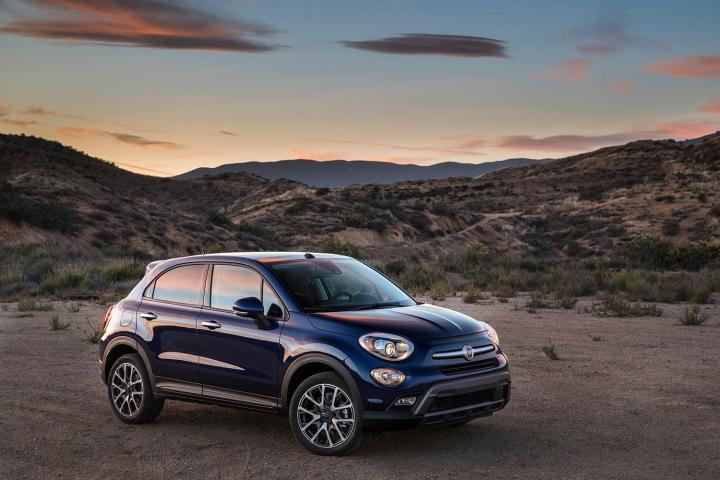The 500X manages to make the jump upmarket and keep its Italian charm intact.
Fiat has long held that good things come in small packages. But can cute scale up? That’s the question asked by the 2016 Fiat 500X, bound for these shores as we speak. The Fiat won’t be able to rely on looks alone. The 500X will make landing in the U.S. with other new immigrants, trying to make a space for itself in the new world alongside strong competition from Honda’s HR-V and Mazda’s CX-3. Will the up-sized 500 have what it takes to stand out in the market’s hottest new segment? Let’s have a look.
Standout
The 500X stands out in the California sun. That Italian charm is laid on hard, from the classic Altoid headrests to the familial character lines in the body. On appearances alone, the 500X grew up nicely. Designed from the get-go to be Fiat’s halo car, one sold in 100 countries and holding down the bulk of Fiat’s sales in mature markets like the U.S., the looks of the Fiat 500X had to be good and almost universally enticing. They are.
It takes a reminder that the 500X is a fundamentally inexpensive thing. It starts cheap, at right around $20,000 for the pared-down “Pop” trim package. Upgrade the powertrain, throw a little trim at the thing, and class up the interior, and you’ve got the Trekking model. Once again, it’s thrifty, clocking in at $24,000. Even if you’re buying from the top of the 500X heap, it’s tough to bust through $30k. That’s Fiat’s stock in trade, Italian panache on the cheap.
If anything benefits from the increase in scale, it’s the interior of the 500X. With room to breathe, handsome leather, and 6.5-inch entertainment and navigation units have taken root and flourished in the larger of the 500s. Uconnect controls adorn flat-bottomed, leather-wrapped steering wheels. Together, they’ve made Fiat’s best interiors downright satisfying, while color-matched painted dashes keep the family legacy alive.
Miraculously, the 500X manages to make the jump upmarket and keep its Italian charm intact.
Those same glowing oranges, Popsicle reds and inky blues contrast nicely with the light straw browns of the canyons north of Los Angeles. It’s clear out on the backroads that the chief appeal of the 500X is appeal itself. The 500X shares underpinnings with its stable mate, the 500L. The unfortunate 500L has proven to be a dog in both looks and sales. Fortunately, those shared guts are good, as demonstrated by another platform-mate, Jeep’s 2015 Renegade, and the 500X isn’t adverse to a little hustle.
Like the Jeep, the 500X can be had in FWD or AWD, and with a choice of familiar engines plucked from the Dodge Dart. Both are plucky, competent little four-bangers. Almost every America-bound 500X will roll with a 180-horsepower, 2.4-liter inline-four-cylinder and nine-speed automatic transmission. Together, they’re a nice little package.
Morning romp
A morning romp through coastal canyons showed off the merits of the Italian way of doing things. With the windows down, the 2.4-liter Tigershark engine rasps out a nice little song. Buttoned up, all is quiet and dignified. It’s a tasteful contrast with optional extras like the dual-pane sunroof and eight-speaker premium audio system. Lane departure warning and forward collision warning systems help out on the highway and give the 500X a feature set above its pay grade.

Throughout the morning, our lightly equipped FWD Easy edition struggled a little to stay composed atop its Nexen tires. A quick trip through Lounge and Trekking editions on different wheel and tire setups was enough to suggest the problem was limited to one pre-production model. The rest of the herd had no trouble bending into the turns with Italian aplomb. The optional AWD system, which can decouple from the rear axle for improved efficiency, only added mass on California’s dry roads. The $1,900 package has proven its worth motivating the Renegade though, and shouldn’t be discounted if your roads tend toward the slick or slippery.
The real surprise in the 500X lineup is the amusing and stripped-down base version, called the Pop, which sports front-wheel-drive only and Fiat’s endlessly charming turbocharged 160-hp, 1.4-liter MultiAir engine. Maybe it’s the six-speed manual, maybe it’s the soundtrack of the little four-cylinder trying to muscle around the nearly 3,000-lb 500X, or maybe it’s just sentimentality, but the Pop is the package that best captures the Italian spirit that made the original 500 a charmer.
The competition has party tricks. Good ones. Honda’s HR-V boasts an enormously useful origami interior. Mazda’s CX-3 is expected to be a sensation on backroads, while achieving similarly sensational fuel economy. There’s no question the 500X is the most Italian of the lot, and Italian charm is a commodity in itself.
Conclusion
Scale is critical to the likeability of the Fiat 500 family. In a diminutive package, quirks and flaws are quickly dismissed as character and charisma.
We delight in that tiny scale because it means being a little ridiculous. “It’s just an Italian thing!” can be applied as enthusiastically to the joyfully barbaric exhaust note of Fiat’s 500 Abarth as it can the squeaking painted dash of the most economical 500 urban runabout.
Miraculously, the 500X manages to make the jump upmarket and keep its Italian charm intact.
Highs
- Italian charm to scale
- Quiet on the inside, Italian soundtrack on the outside
- Slightly unrefined
Lows
- Seats for five, thrills for none
- Slightly unrefined









